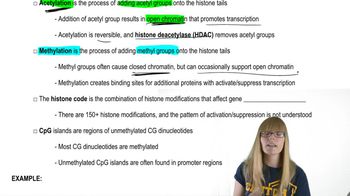Table of contents
- 1. Introduction to Genetics51m
- 2. Mendel's Laws of Inheritance3h 37m
- 3. Extensions to Mendelian Inheritance2h 41m
- 4. Genetic Mapping and Linkage2h 28m
- 5. Genetics of Bacteria and Viruses1h 21m
- 6. Chromosomal Variation1h 48m
- 7. DNA and Chromosome Structure56m
- 8. DNA Replication1h 10m
- 9. Mitosis and Meiosis1h 34m
- 10. Transcription1h 0m
- 11. Translation58m
- 12. Gene Regulation in Prokaryotes1h 19m
- 13. Gene Regulation in Eukaryotes44m
- 14. Genetic Control of Development44m
- 15. Genomes and Genomics1h 50m
- 16. Transposable Elements47m
- 17. Mutation, Repair, and Recombination1h 6m
- 18. Molecular Genetic Tools19m
- 19. Cancer Genetics29m
- 20. Quantitative Genetics1h 26m
- 21. Population Genetics50m
- 22. Evolutionary Genetics29m
13. Gene Regulation in Eukaryotes
Epigenetics, Chromatin Modifications, and Regulation
Problem 2
Textbook Question
Write a short essay describing how epigenetic changes in cancer cells contribute to the development and maintenance of cancers.
 Verified step by step guidance
Verified step by step guidance1
Step 1: Begin by defining epigenetics, which involves changes in gene expression that do not alter the DNA sequence itself. These changes can include DNA methylation, histone modification, and non-coding RNA molecules.
Step 2: Explain how epigenetic changes can lead to cancer by silencing tumor suppressor genes or activating oncogenes. For example, hypermethylation of promoter regions can silence genes that normally inhibit cell growth.
Step 3: Discuss the role of histone modifications in cancer. Acetylation and deacetylation of histones can alter chromatin structure, affecting gene expression. In cancer, these modifications can lead to inappropriate activation or repression of genes involved in cell cycle regulation.
Step 4: Describe how non-coding RNAs, such as microRNAs, can contribute to cancer by regulating gene expression post-transcriptionally. Dysregulation of these RNAs can lead to the overexpression of oncogenes or the silencing of tumor suppressor genes.
Step 5: Conclude by highlighting that epigenetic changes are reversible, which presents potential therapeutic opportunities. Drugs targeting epigenetic modifications, such as DNA methyltransferase inhibitors and histone deacetylase inhibitors, are being explored as cancer treatments.
Recommended similar problem, with video answer:
 Verified Solution
Verified SolutionThis video solution was recommended by our tutors as helpful for the problem above
Video duration:
2mPlay a video:
Was this helpful?
Key Concepts
Here are the essential concepts you must grasp in order to answer the question correctly.
Epigenetics
Epigenetics refers to the study of heritable changes in gene expression that do not involve alterations to the underlying DNA sequence. These changes can be influenced by various factors, including environmental stimuli, lifestyle, and developmental stages. In cancer, epigenetic modifications can lead to the activation of oncogenes or the silencing of tumor suppressor genes, contributing to tumorigenesis.
Recommended video:
Guided course

Chromatin
DNA Methylation
DNA methylation is a key epigenetic mechanism involving the addition of a methyl group to the DNA molecule, typically at cytosine bases. This modification can repress gene expression and is often found in cancer cells, where abnormal methylation patterns can silence genes that normally prevent tumor growth. Understanding these patterns is crucial for elucidating how cancers develop and persist.
Recommended video:
Guided course

DNA Proofreading
Histone Modification
Histone modification involves the chemical alteration of histone proteins around which DNA is wrapped, influencing chromatin structure and gene accessibility. These modifications, such as acetylation and phosphorylation, can either promote or inhibit gene expression. In cancer, altered histone modifications can lead to the dysregulation of genes involved in cell cycle control and apoptosis, thereby supporting cancer cell survival and proliferation.
Recommended video:
Guided course

Histone Protein Modifications




